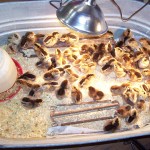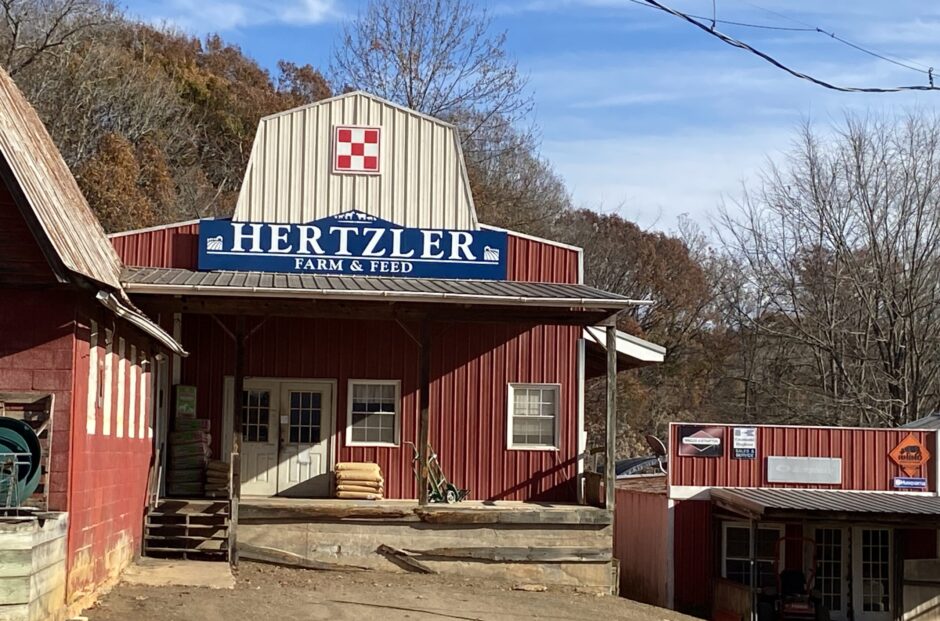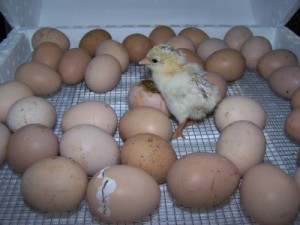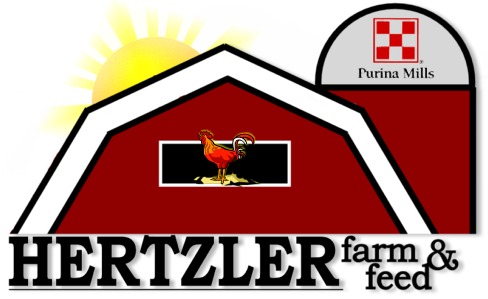| 1. What type of cage or container should I put my chicks in when I take them home?

|
| Chicks are like babies and need to be kept warm. Place your chicks in a large cardboard or wooden box that is approx 3′ by 3′ and draft free. Line the bottom with newspaper and then dry sawdust, shavings or crushed corn cob. Keep the litter dry by changing frequently. |
|
| The sides of your box should not be over 14-18″ high. Never use solid high sides because the heat can cut off circulation of air and smother the chicks. Hang your heat lamp 18-20″ above the birds in a cold area and 24-27″ in a warmer area. It is very important to place the heat lamp at a height that the birds are comfortable underneath the lamp but can also move away from it if they become too warm. When a heat lamp is too close to the birds, it creates unbearable heat and they can become burned. |
|
| Just putting your box by the wood stove does not provide the same consistency of heat as a heat lamp. |
|
| 2. Can I use an ordinary light bulb? |
Never use ordinary light bulbs. They are meant to produce light and do not have the heating qualities of a heat lamp. A heat lamp is coated with silver to reflect or shoot the heat to the birds which is needed for survival.
|
| 3. How many birds will one lamp provide for? |
One 250 heat lamp will sufficiently warm 25 goslings, 50 ducklings, 50 turkeys or up to 100 chicks.
|
| 4. How long do I leave the heat lamp on? |
| Brooding temperatures—————————–First week |
| Goslings and Ducks——————————–85 degrees |
| Chicks———————————————90 degrees |
| Turkeys——————————————–95 degrees |
| Guineas and Game birds—————————-95 degrees |
|
| Decrease 5 degrees weekly depending on room temperature. After 2-3 weeks, once chicks start to get feathers, they don’t need heat. When I wean my chicks off heat, I use heat at night as the nights are typically cooler. |
|
| 5. Do I need to use litter in the box? |
| YES! On bare floors, use newspaper or cardboard as, your birds can slip and become spraddle legged. If per chance one of your birds becomes spraddle legged, fasten a soft cord to one leg at the ankle and also to the other ankle, leaving a space between the legs as it should be. The bird will be able to walk with this support and in a few days the cord can be removed. |
|
| 6. What do my chicks need to drink? |
| Fresh water should be available at all times. Purchase regular chick waterer from you local farm supply store. We have several kinds available and they are inexpensive. Never use make-shift watering devices such as a pan or saucer of water. If the birds fall in the water or get wet, they will get chilled and die. Even baby goslings and ducklings die when they get wet. |
| Game birds, quail and chukars are very tiny and they need a special waterer that has a much smaller lip. |
| After ducklings and goslings are several weeks old, they enjoy a small pan of water to splash and play in. They will make a terrible mess so be prepared! However, they do not get their body and wing feathers until they are four weeks old and until then can not swim and should be put inside when it rains. Baby ducks and geese in the wild get oil from their mothers body to help them swim. Yours will have to wait until they develop their own feathers and their oil glands start to work before they can go for the big swim. |
|
| 7. What do my chicks need to eat? |
| Keep a commercial, crumbled, baby chick feed available to your chicks all the time. They will not overeat. If chicks are without feed for even the shortest amount of time they will act as though they are starved. Poultry and waterfowl of any breed cannot exist or will get cripple in the legs if only fed bread crumbs, egg yolks, oatmeal or cornmeal. These foods do not provide a balanced ration. A crumblized feed is most beneficial because it is in a compacted form. A pelleted feed, even small pellets, are too large for most baby poultry and water fowl. |
| Chickens, Game birds and Guineas : Use Start and Grow until the birds are 6 months of age and ready to start laying. One of the most common chicken diseases is Coccidiosis. This is evident by blood in the droppings. Some starter feeds contain medication to prevent this disease, or you use Ren O Sal tablets as a precaution. Purina Liquid Sulfa-Nox (1 oz. per gal.) is another good preventive/corrective medication. Terramycin is a good medication to have on hand to use against a wide variety of poultry diseases of respiratory and intestinal origin. |
| Cannibalism is when the birds pick each other to the extent of drawing blood. This is one of the most common problems you will have. It usually happens under crowded conditions. Give the chicks more space and use toenail clippers to snip a small portion of the top beak off. This will nor hurt the chick, and they can still eat but it discourages cannibalism. Once a chick has drawn blood they will literally pick the chick to death unless you separate the injured chick until healed. Even then they sometimes will pick the chick again as soon as you put it back into the pen. |
| Pheasants, Quail, Chukars : Use a medicated Game bird Startena(30% Protein) for the first 6 weeks. Then switch to Game bird Flight Conditioner (19% Protein) until birds are 16 weeks old. |
| Goslings and Water fowl : Use UNMEDICATED Chick Start and Grow. They are easy to raise and very disease resistant and cannot tolerate the medication that is helpful to chickens. Goslings have a tendency to pick each other to the extent of baring their backs. Another problem that develops in geese is “Angel wing” (click here for more information) or slipped, crooked or bent wing. This is a condition where the last joint of the wing is twisted and the wing feathers point out, and do not lay smooth against the body. It does not hurt the goose as domestic geese don’t fly anyways but they don’t look quite normal. One way to help prevent this from happening is to give them more room and put clumps of grass ( ground and all) in their pens. The grass is also needed daily to help prevent crippled legs. |
| Turkeys and Heavy breed Chicks such as Cornish Super Giants or Cornish Rock Cross need medicated meat builder. It is higher in protein and other ingredients needed to meet their fast growth demand and prevent leg problems. It is very helpful to use vitamins in the drinking water to help alleviate weak legs. Solutracin should be put into the drinking water of all Turkeys, particularly when shipped by mail as this exposes babies to heat cold and stress. Solutracin acts on the gut and fortifies baby turkeys with livability and a desire to start eating.Turkeys are not very intelligent when it comes to eating and drinking; they need to be taught. The stories you hear about baby turkeys looking up in the rain and drowning are true. Put marbles (or something shiny) in their water and feed. The turkeys will peck at the shiny marbles and learn to eat and drink. Occasionally this will not work. In that case sprinkle green food coloring over feed or put some baby chicks in to teach them to eat. After a few days they will be well educated. |
|
8. How do I care for my chicks as they grow?
| Chickens take up to six months to be fully grown and lay eggs. As they grow, you need to enlarge the cage. They cannot fend for themselves and need protection from predators until they are 6 months of age. |
| Cold weather does not bother a full grown chicken. It should have shelter from the rain and sun but an open barn roof is sufficient. |
| Chickens like to roost up off the ground at night. They like a box or tire with straw to lay eggs in. If chickens are let out of the chicken house they will go back in and lay eggs and roost. It is a good idea to shut the door on the chicken house at night as they are very easy prey for predators. |
| Chickens need Layena crumbles or pellets available at all times. This is a complete balanced ration formulated for egg production and maintaining good body weight. Cracked corn or scratch grains will not do the job. You can throw a handful to them as “candy” as they love it but don’t make it their main feed. If you feed Layena, you should not need to feed grit. Grit is only needed when chickens are feed whole grains. It acts as “teeth” in the craw, grinding up the grains so that the chicken can digest the nutrients in the grains. Oyster shell should be fed as a free-choice supplement. This helps to prevent weak egg shells. It is like a person taking calcium tablets. |
| Chickens will lay eggs for several years. Each year the production is not as good and the quality of the egg shell will not be as good. Chickens are light sensitive and shorter days mean less egg production. When the days get shorter chicken also molt, or lose their feathers. This is normal, but take heart, soon the days will be longer again and they get back all their feathers and lay eggs again. This can be counteracted by putting lights on the chickens to extend the length of the day. |
| Turkeys : Until a turkey is 6 months of age they do nothing but try to think of ways to die. If you get them at this age you have it made. You can turn him/her loose and they will stay around the yard and can fend for himself in any weather. Your biggest concern is predators. |
| At 4-6 months turkeys prefer a pelleted feed (Pelleted Flock Raiser or Layena). Cracked corn or scratch grains may added to their feed. Do not mix turkeys with chickens as they are very susceptible to chicken diseases. Turkeys like to roost up on a gate or a fence. |
| Guineas : Raise the same as chickens. By 5 months they are full grown and can pretty much fend for themselves. They like to roost high in trees. Unlike chickens they do not scratch. They are known for their debugging qualities! Because they are scroungers, they like to hunt for their food and a supplement of scratch grains or Layena is all that is needed. |
| The adult females make a two syllable noise (easy to remember because women like to talk!!!) and their waddles are smaller and slant towards the back while the males make a short one syllable squawk and their waddles are larger and hang down. |
| Ducks and Geese : By 6 weeks of age, they are pretty well feathered out, their oil glands are working and they are ready for the big swim. They enjoy a pelleted feed mixed with whole corn. Ducks and Geese naturally eat mostly grass. It does not take much grain to supplement their diet. |
| Contrary to what you might think, you do not need a pond to have ducks. A child’s wading pool works nicely. They like to mate in water and need water to hatch their eggs. They need to be able to get their feathers wet in order to keep their eggs moist. |
| Adult male ducks can be distinguished by a curl on the end of their tail. Domestic ducks, unlike their “wild” cousins can not fly and do not migrate. They may be able to get up in the air enough to clear a fence if frighten and they have enough of a running start. |
| Muscovy ducks are solid white and have the reputation of eating snakes. They have been known to attack and kill snakes. They are also a flying duck (can fly just enough to get up on a barn roof or fence), noiseless and very ugly! (matter of opinion!)
|
|
|
9. How can I tell the male babies from the female babies?
| Chickens: There are several “theories” but one I have found to be the most accurate….is using a nail, needle or ring, fastened to a 6-8 inch piece of sewing thread. Hold the string with the nail swinging freely above the chick. The string will swing in a circle if it is a female and back and forth if it is a male. You can try this over people’s wrists. It is fun and makes for very interesting conversation. I do not know why it works but we have found it to be very accurate. However, I must say it does make mistakes and is not 100%. It seems to make more errors on turkeys than any other animal. It also works over eggs! I have noticed that neutered animals swing the opposite of what they actually are. In other words, a neutered female dog shows to be a male!! The string “trick” also does not work for everyone. |
Some breeds, that are crosses such as Comets, Sex Sals, Sex Links, the roosters are yellow (as chicks) and the hens red or black, which ever the case. In chicks, yellow feathers turn white or red when full grown.
Turkeys : Some Toms ( male turkeys) start strutting at a very young age. By careful observation I have sometimes guessed correctly.
| Ducks and Geese : By 5-8 weeks of age the hens of most breeds can be distinguished by their voices. To sex by this method, catch each duck individually and as it protest its predicament, listen carefully for the hen’s distinctive quack. The most sure way is to examine the pelvic area. |
|
|
|
10. Do you need a rooster to have eggs?
No. Chickens lay eggs just fine without a rooster. However, the eggs are not fertilized which means they won’t hatch. You can not tell the difference in taste between a fertile or non-fertile egg.
|
| 11. Are brown eggs different from white eggs? |
|
No. Eggs are eggs, however brown eggs are often better in flavor than white eggs. It is not the eggs but how they are raised that makes the difference.
|
Commercial growers usually have White Leghorn chickens which are superb egg layers with good feed conversion/body weight. Leghorns lay white eggs. The chickens are kept in a highly controlled environment and usually never see the light of day.
|
|
Homeowners prefer a larger more docile hen for their home flock (Barred Rocks, Sex Sal, Sex Link, Rhode Island Reds etc.) These chickens lay brown eggs. They get to enjoy the luxury of sunlight, grass, vegetable scraps ( chickens love watermelon, tomatoes, lettuce etc.) and often freely roam the barnyards and pastures. The carotene that makes grass green makes egg yolks orange and rich looking. This makes them better in flavor and nutrients. But if Leghorns were given the same treatment, their white eggs would be just as good. The size of eggs are determined by the amino acid level in the feed. For instance, Purina’s Layena is formulated for jumbo eggs.
|





